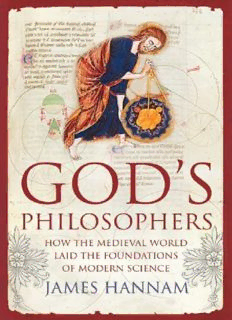
God's Philosophers: How the Medieval World Laid the Foundations of Modern Science PDF
Preview God's Philosophers: How the Medieval World Laid the Foundations of Modern Science
God’s Philosophers HOW THE MEDIEVAL WORLD LAID THE FOUNDATIONS OF MODERN SCIENCE JAMES HANNAM ICON BOOKS Published in the UK in 2009 by Icon Books Ltd, Omnibus Business Centre, 39–41 North Road, London N7 9DP email: [email protected] www.iconbooks.co.uk This electronic edition published in 2009 by Icon Books ISBN: 978-1-84831-158-9 (ePub format) ISBN: 978-1-84831-159-6 (Adobe ebook format) Printed edition (ISBN: 978-1-84831-070-4) Sold in the UK, Europe, South Africa and Asia by Faber & Faber Ltd, Bloomsbury House, 74–77 Great Russell Street, London WC1B 3DA or their agents Distributed in the UK, Europe, South Africa and Asia by TBS Ltd, TBS Distribution Centre, Colchester Road Frating Green, Colchester CO7 7DW This edition published in Australia in 2009 by Allen & Unwin Pty Ltd, PO Box 8500, 83 Alexander Street, Crows Nest, NSW 2065 Distributed in Canada by Penguin Books Canada, 90 Eglinton Avenue East, Suite 700, Toronto, Ontario M4P 2YE Text copyright © 2009 James Hannam The author has asserted his moral rights. No part of this book may be reproduced in any form, or by any means, without prior permission in writing from the publisher. Typeset by Marie Doherty To Vanessa CONTENTS List of Illustrations Map of medieval Europe Introduction: The Truth about Science in the Middle Ages Chapter 1: After the Fall of Rome: Progress in the Early Middle Ages Chapter 2: The Mathematical Pope Chapter 3: The Rise of Reason Chapter 4: The Twelfth-Century Renaissance Chapter 5: Heresy and Reason Chapter 6: How Pagan Science was Christianised Chapter 7: Bloody Failure: Magic and Medicine in the Middle Ages Chapter 8: The Secret Arts of Alchemy and Astrology Chapter 9: Roger Bacon and the Science of Light Chapter 10: The Clockmaker: Richard of Wallingford Chapter 11: The Merton Calculators Chapter 12: The Apogee of Medieval Science Chapter 13: New Horizons Chapter 14: Humanism and the Reformation Chapter 15: The Polymaths of the Sixteenth Century Chapter 16: The Workings of Man: Medicine and Anatomy Chapter 17: Humanist Astronomy and Nicolaus Copernicus Chapter 18: Reforming the Heavens Chapter 19: Galileo and Giordano Bruno Chapter 20: Galileo and the New Astronomy Chapter 21: The Trial and Triumph of Galileo Conclusion: A Scientific Revolution? Suggestions for Further Reading Timeline List of Key Characters Notes Bibliography of Works Cited Acknowledgements LIST OF ILLUSTRATIONS 1. Ottoman astrolabe from the Musée de l’Institut du Monde Arabe, Paris 2. Map from Isidore of Seville, Etymologiae (Augsburg: Günther Zainer, 1472) 3. Diagram of the universe from Peter Apian, Cosmographia (Antwerp: Arnold Berckmann, 1539) 4. Manuscript illumination by Laurentius de Voltolina from the Kupferstichkabinett, Staatliche Museen zu Berlin 5. Manuscript illumination from Bible Moralisee, Vienna, Österreichische Nationalbibliothek, MS Codex Vindobonensis 2554 6. Manuscript initial from Johannitius, Isagoge, Bethesda MA, National Library of Medicine, MS DeRicci [78] 7. Photograph of a large trebuchet 8. Eastern and western Arabic numerals compared to modern western numerals 9. Diagram from Nicole Oresme’s De configurationibus qualitatum, Florence, Biblioteca Nazionale Centrale, MS Conv. Soppr. J. IX. 26 10. A map of the world from Ptolemy, Geographia (Ulm: Leonard Hol, 1482) 11. Woodcut from Johannes de Ketham, Fasiculo de medicina (Venice: Zuane & Gregorio di Gregorii, 1494) 12. Woodcut of a standing flayed figure from the studio of Titian in Andreas Vesalius, De fabrica corporis humanis (Basle: Joannes Oporinus, 1543) 13. A woodcut of a uterus from Vesalius, De fabrica 14. Model of the universe from Johann Kepler, Mysterium cosmographicam (Tübingen: Georgius Gruppenbachius, 1596) 15. A diagram from Galileo Galilei, trans. Henry Carew and Alfonso de Salvio, Dialogues Concerning Two New Sciences (New York: Macmillan, 1914) 16. A diagram from William Heytesbury, Regule solvendi sophismata (Venice: Bonetus Locatellus, 1494) Map of medieval Europe
Description: